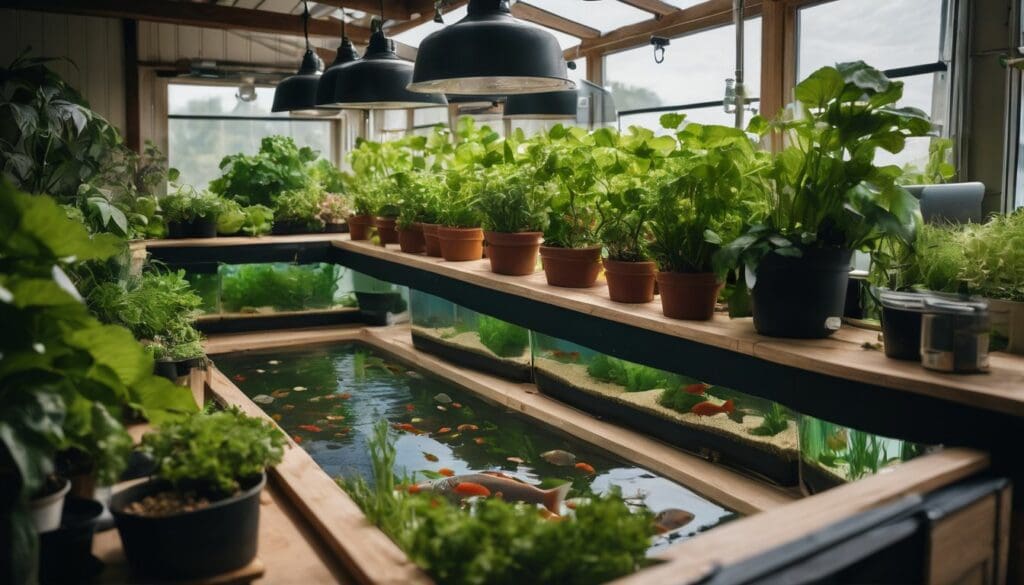Are you pondering over how to nurture our food in a way that’s kinder to our planet, while keeping up with the appetites of an ever-increasing population? We’ve been scratching our heads about this too, and stumbled upon aquaponics—a rather clever system that slurps up 90% less water than old-school farming techniques.
Our upcoming article is set to peel back the layers on the marvels of aquaponics, where finned friends and green shoots coexist in a harmony that could just reimagine the way we approach sustainable nosh.
Time to dive into this fascinating read and explore how this compact ecosystem, perhaps nestled right next door, has the potential to provide a bountiful feast for future generations!
Key Takeaways
- Aquaponics is an eco – friendly farming method that uses 90% less water than traditional agriculture by merging fish farming with hydroponic plant growth.
- This sustainable approach not only saves water but also avoids the need for harmful chemical fertilisers and pesticides, benefiting our environment and health.
- Systems can be set up in diverse environments including urban areas, making it a versatile option for producing fresh vegetables and protein-rich fish year-round.
- Choosing suitable fish like tilapia or trout and designing effective grow beds are crucial to ensure the system functions efficiently.
- Innovations in aquaponics technology are enhancing system monitoring and operation, contributing to its potential as a global solution for food security challenges.
What is Aquaponics?
Transitioning from our introduction into the core of sustainable food production, let’s dive deeper into aquaponics. This innovative approach to farming merges aquaculture and hydroponics, allowing us to raise fish and grow plants in one integrated system.
The magic happens as fish produce waste that becomes a natural fertiliser for the plants. In turn, these plants filter and clean the water that goes back to the fish.
We embrace this cycle because it stands out as an eco-friendly solution requiring far less water than traditional agriculture methods. Aquaponics can be set up almost anywhere, making it ideal for urban environments where space is at a premium.
It gives us control over what we eat by providing fresh vegetables alongside healthy protein from fish – without relying on pesticides or chemical fertilisers.
Benefits of Aquaponics
Aquaponics offers a sustainable approach to food production, efficiently utilising water and land resources while improving food security. By combining fish farming with vegetable production, this innovative system provides a practical solution for small-scale farming and contributes to global food sovereignty.
Sustainable food production
Sustainable food production is a key benefit of aquaponics. This method allows for the efficient use of water and land resources, addressing food security challenges in an environmentally friendly way.
By integrating fish farming with vegetable production, aquaponics provides a promising tool for sustainable agriculture. It minimises the need for synthetic fertilisers and pesticides while using 90% less water compared to traditional farming methods.
Aquaponics offers an innovative approach to producing food sustainably by combining fish and plant cultivation. This system utilises renewable resources and eliminates waste, making it an ideal choice for small-scale farming and urban agriculture.
Efficient use of water and land resources
Aquaponics is an innovative and sustainable farming practice that efficiently utilises water and land resources. By combining fish farming with hydroponic plant cultivation, aquaponics maximises the use of water, requiring 90% less than traditional agriculture.
This method addresses the pressing issue of water scarcity while producing both fish and vegetables simultaneously, using the same amount of water. The efficient use of land in aquaponics results in higher crop yields compared to conventional farming, making it an ideal solution for small-scale urban farming and addressing food security challenges.
Aquaponics is a game-changer in sustainable agricultural innovation, offering gamers an exciting opportunity to explore new methods of food production that make a positive impact on the environment while providing fresh, organic produce.
Improved food security
Aquaponics enhances food security by providing a consistent supply of fresh fish and vegetables. This method is especially beneficial in areas where traditional agriculture faces challenges such as limited water resources or soil degradation.
By integrating fish and plant production, aquaponics offers a sustainable solution to increase access to nutritious food, contributing to improved community resilience.
This approach contributes significantly to reducing the dependence on external food sources and enhancing self-sufficiency. With the potential for year-round production in controlled environments, aquaponics can play a vital role in ensuring stable access to essential nutrients without being heavily reliant on conventional agricultural practices that are vulnerable to climate-related disruptions.
Moving forward, advancements in aquaponics technology hold promise for addressing global food security concerns while promoting sustainable farming methods that may be adopted at varying scales across different regions worldwide.
Components of an Aquaponics System
The components of an aquaponics system include a fish tank, a grow bed, and plumbing for water circulation. To learn more about how these components work together to create a sustainable food production system, read on!
Fish tank
The fish tank is a crucial component of the aquaponics system. It provides a suitable environment for the fish to thrive and produce waste that will be used to nourish the plants. The tank should be large enough to accommodate a sufficient number of fish, allowing them room to move comfortably.
In an aquaponics setup, the water from the fish tank is circulated into the grow beds where it delivers essential nutrients for plant growth before returning back to the fish tank, creating a sustainable cycle.
It’s important to consider factors such as water quality and temperature when choosing or setting up a fish tank in an aquaponics system. Additionally, maintaining proper filtration and ensuring adequate oxygen levels are essential for the health and well-being of the aquatic organisms within this closed-loop ecosystem.
Grow bed
Transitioning from the fish tank to the next essential component, the grow bed plays a crucial role in an aquaponics system. This is where plants are grown using water and nutrients from the fish waste.
The grow bed can come in different forms such as media-based, deep-water culture, or nutrient film technique. The media-based grow bed typically uses gravel or clay pellets as a growing medium for plants.
Deep-water culture involves suspending plant roots directly into nutrient-rich water, while the nutrient film technique uses a thin film of water flowing through channels to provide nutrients to the plants.
Plumbing and water circulation
Plumbing and water circulation in aquaponics systems play a crucial role in maintaining the balance between fish waste, nitrifying bacteria, and nutrient absorption by plants. The plumbing system ensures that water from the fish tank flows into the grow bed, allowing plants to absorb essential nutrients from the fish waste.
Efficient water circulation prevents stagnation and maximises nutrient distribution throughout the system, promoting healthy plant growth while maintaining optimal conditions for aquatic life.
The plumbing components consist of pipes, valves, and pumps that work together to facilitate continuous water flow. This circulation ensures that oxygenated water reaches both fish and plants, creating an environment where they can thrive symbiotically.
Choosing the Right Fish for Aquaponics
When choosing the right fish for aquaponics, select species that thrive in a closed system and are compatible with the plants you want to grow. Popular choices include tilapia, trout, catfish, and perch. Consider the following factors when selecting fish for your aquaponics system:
- Size: Opt for fish species that are suitable for your available space and climate conditions; smaller tanks may be better suited to smaller fish species.
- Temperature Tolerance: Choose fish that can tolerate fluctuations in water temperature and are well-suited to your local climate.
- Feeding Habits: Consider the feeding habits of the fish and ensure they align with the type of feed available to you; some species are herbivorous, while others are omnivorous or carnivorous.
- Growth Rate: Select fish species with a relatively fast growth rate to ensure a sustainable production cycle and efficient use of resources.
- Disease Resistance: Look for fish varieties resistant to common diseases to minimise the risk of health issues within your aquaponics system.
Types of Grow Beds
There are three main types of grow beds used in aquaponics systems, including media-based, deep-water culture, and nutrient film technique. Each type has its own advantages and can be tailored to suit different plants and growing conditions.
These grow beds play a crucial role in providing the necessary nutrients to the plants while also maintaining water quality for the fish.
Media-based
In media-based aquaponics systems, the grow bed is filled with a medium such as gravel, clay pellets, or lava rocks. These materials provide a surface for beneficial bacteria to thrive and convert fish waste into plant nutrients.
The media also helps to support the plants as they grow, ensuring stability and adequate root development. This method is popular for its simplicity and versatility, making it suitable for various plant types and sizes.
The use of media in this system promotes a healthy environment for both fish and plants by maintaining proper filtration and oxygenation levels. Additionally, media-based aquaponics allows for easy customisation based on specific crop requirements, making it an ideal choice for those looking to experiment with different plant varieties while enjoying sustainable food production.
Deep-water culture
Transitioning from media-based grow beds, another type used in aquaponics systems is deep-water culture. In this method, plants are suspended above a body of water with their roots submerged below the surface.
Nutrient-rich water continuously flows over the roots, providing oxygen and nutrients essential for plant growth. This technique allows for efficient nutrient uptake while reducing the need for soil altogether.
Deep-water culture is particularly suitable for leafy greens and herbs due to its continuous supply of water and nutrients.
This hydroponic approach offers an innovative way to cultivate plants without soil, making it ideal for sustainable food production in aquaponics systems. The constant circulation of nutrient-rich water promotes fast growth and high yields, creating a productive environment for various crops.
Nutrient film technique
Transitioning from deep-water culture, the nutrient film technique (NFT) is another method used in aquaponics for growing plants. In this system, a thin film of water containing dissolved nutrients flows through shallow channels where plant roots are suspended.
The constant flow of water provides essential nutrients to the roots while also ensuring adequate oxygenation. This method allows for efficient use of space and uses minimal water compared to traditional soil-based agriculture.
The Nutrient Film Technique offers an excellent way to grow plants hydroponically within an aquaponics system. It utilises a continuous flow of nutrient-rich water that supports plant growth without soil, making it a space-saving and sustainable option for cultivating a variety of crops in an aquaponic setting.
Conclusion and the Future of Aquaponics
In conclusion, aquaponics offers a promising solution for sustainable food production by combining fish and plants in an efficient and environmentally friendly system. To learn more about the potential of aquaponics and its future advancements, keep reading!
Potential for addressing food security and sustainability challenges
Aquaponics holds great promise in addressing food security and sustainability challenges. This innovative system utilises 90% less water than traditional agriculture, making it an efficient and environmentally friendly method of food production.
By cultivating fish and vegetables together, aquaponics offers a sustainable farming solution that eliminates the need for synthetic chemical fertilisers and pesticides, promoting organic farming practices.
The combination of aquaculture with hydroponics not only maximises land use but also provides an opportunity for small-scale, soilless, and organic farming. Aquaponics presents a new way to grow sustainable food by integrating fish and plant production, offering a promising tool for environmentally friendly food production.
Current advancements and innovations in aquaponics technology
Aquaponics technology has seen significant advancements and innovations in recent years. The development of smart monitoring systems allows for real-time tracking of water quality, temperature, and nutrient levels, ensuring optimal conditions for both fish and plants.
Additionally, the integration of automated feeding systems enhances efficiency and reduces manual labour, making aquaponics more accessible to small-scale farmers. Innovations in greenhouse gardening techniques have expanded the potential for year-round cultivation in various climate conditions, further promoting sustainable food production.
Improved methods of water filtration and recirculation contribute to enhanced resource utilisation while reducing environmental impact. Furthermore, ongoing research into new grow bed designs and plant varieties aims to increase productivity and diversify crop options within aquaponics systems.
Potential for expansion and adoption in different regions of the world.
Current advancements and innovations in aquaponics technology have opened up the potential for expansion and adoption in different regions of the world. The adaptability of aquaponics to various climates and environments offers an attractive solution for small-scale farming, especially in arid or urban areas where soilless farming is essential.
With its emphasis on sustainable food production, aquaponics aligns with principles of permaculture and provides a promising method for addressing food security challenges globally.
This approach has considerable potential for widespread adoption, particularly in regions where access to water and land resources is limited.
Aquaponics also offers significant benefits such as efficient use of scarce water resources, making it well-suited for areas facing water scarcity issues. By combining fish and plant production, this innovative system can contribute positively to local economies while promoting environmentally friendly practices.
FAQs
1. What is aquaponics?
Aquaponics is a sustainable way of growing food that combines raising fish and plants together in one integrated system.
2. How does an aquaponic system work?
In an aquaponic setup, the waste produced by fish supplies nutrients for plants, which in turn clean the water for the fish, creating a cycle of mutual benefit.
3. Can aquaponics be done on a small scale?
Yes, aquaponics can be adapted to small-scale farming and even urban spaces to grow fresh produce right at home.
4. Why is aquaponics considered sustainable?
Aquaponics uses less water than traditional farming, doesn’t need artificial fertilisers since it uses natural fish waste as plant food, and grows healthy food without harming any ecosystems.





